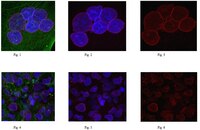Nesprin-2 interacts with meckelin and mediates ciliogenesis via remodelling of the actin cytoskeleton.
Dawe, Helen R, et al.
J. Cell. Sci., 122: 2716-26 (2009)
2009
Mostra il sommario
Meckel-Gruber syndrome (MKS) is a severe autosomal recessively inherited disorder caused by mutations in genes that encode components of the primary cilium and basal body. Here we show that two MKS proteins, MKS1 and meckelin, that are required for centrosome migration and ciliogenesis interact with actin-binding isoforms of nesprin-2 (nuclear envelope spectrin repeat protein 2, also known as Syne-2 and NUANCE). Nesprins are important scaffold proteins for maintenance of the actin cytoskeleton, nuclear positioning and nuclear-envelope architecture. However, in ciliated-cell models, meckelin and nesprin-2 isoforms colocalized at filopodia prior to the establishment of cell polarity and ciliogenesis. Loss of nesprin-2 and nesprin-1 shows that both mediate centrosome migration and are then essential for ciliogenesis, but do not otherwise affect apical-basal polarity. Loss of meckelin (by siRNA and in a patient cell-line) caused a dramatic remodelling of the actin cytoskeleton, aberrant localization of nesprin-2 isoforms to actin stress-fibres and activation of RhoA signalling. These findings further highlight the important roles of the nesprins during cellular and developmental processes, particularly in general organelle positioning, and suggest that a mechanistic link between centrosome positioning, cell polarity and the actin cytoskeleton is required for centrosomal migration and is essential for early ciliogenesis. | 19596800
 |
Nesprin-2 giant safeguards nuclear envelope architecture in LMNA S143F progeria cells.
Kandert, Sebastian, et al.
Hum. Mol. Genet., 16: 2944-59 (2007)
2007
Mostra il sommario
The S143F lamin A/C point mutation causes a phenotype combining features of myopathy and progeria. We demonstrate here that patient dermal fibroblast cells have dysmorphic nuclei containing numerous blebs and lobulations, which progressively accumulate as cells age in culture. The lamin A/C organization is altered, showing intranuclear and nuclear envelope (NE) aggregates and presenting often a honeycomb appearance. Immunofluorescence microscopy showed that nesprin-2 C-terminal isoforms and LAP2alpha were recovered in the cytoplasm, whereas LAP2beta and emerin were unevenly localized along the NE. In addition, the intranuclear organization of acetylated histones, histone H1 and the active form of RNA polymerase II were markedly different in patient cells. A subpopulation of mutant cells, however, expressing the 800 kDa nesprin-2 giant isoform, did not show an overt nuclear phenotype. Ectopic expression of p.S143F lamin A in fibroblasts recapitulates the patient cell phenotype, whereas no effects were observed in p.S143F LMNA keratinocytes, which highly express nesprin-2 giant. Overexpression of the mutant lamin A protein had a more severe impact on the NE of nesprin-2 giant deficient fibroblasts when compared with wild-type. In summary, our results suggest that the p.S143F lamin A mutation affects NE architecture and composition, chromatin organization, gene expression and transcription. Furthermore, our findings implicate a direct involvement of the nesprins in laminopathies and propose nesprin-2 giant as a structural reinforcer at the NE. | 17881656
 |
NUANCE, a giant protein connecting the nucleus and actin cytoskeleton.
Zhen, Yen-Yi, et al.
J. Cell. Sci., 115: 3207-22 (2002)
2002
Mostra il sommario
NUANCE (NUcleus and ActiN Connecting Element) was identified as a novel protein with an alpha-actinin-like actin-binding domain. A human 21.8 kb cDNA of NUANCE spreads over 373 kb on chromosome 14q22.1-q22.3. The cDNA sequence predicts a 796 kDa protein with an N-terminal actin-binding domain, a central coiled-coil rod domain and a predicted C-terminal transmembrane domain. High levels of NUANCE mRNA were detected in the kidney, liver, stomach, placenta, spleen, lymphatic nodes and peripheral blood lymphocytes. At the subcellular level NUANCE is present predominantly at the outer nuclear membrane and in the nucleoplasm. Domain analysis shows that the actin-binding domain binds to Factin in vitro and colocalizes with the actin cytoskeleton in vivo as a GFP-fusion protein. The C-terminal transmembrane domain is responsible for the targeting the nuclear envelope. Thus, NUANCE is the first alpha-actinin-related protein that has the potential to link the microfilament system with the nucleus. | 12118075
 |











